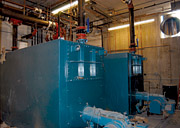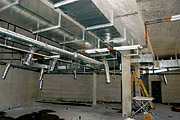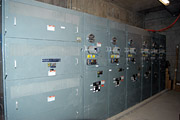
"First Ascent," which is the first phase of the multiphase project, just opened in the fall of 2002. With 139 residential condominiums, 17 retail and restaurant spaces, and a subterranean parking garage, the first phase encompasses about 280,000 sq ft in three buildings. The second phase, "22 Station," is scheduled to be completed in June 2003 and will include about 300,000 sq ft of condominium, parking garage, retail, and restaurant space in two buildings. Other phases will follow in the coming years.
For such a large mixed-use application, the owners required a comprehensive BAS that could efficiently monitor and meter energy usage, be user-friendly for the facility maintenance team, and minimize first costs to the project. Those were the main criteria used by Beaudin-Ganze Consulting Engineers Inc. (BGCE, Truckee, CA) in selecting the correct BAS - and other mechanical systems - for this very large project.

Making the Choice
Choosing a BAS can be a complicated endeavor. Automation systems continue to fluctuate as the technology improves and changes, and BGCE wanted to make sure The Village owners would have components that were available for the BAS now and into the future."The components needed to be readily available to minimize impacts to the schedule, and we also didn't want to go with a product that the installer may not be familiar with. We wanted to make sure the owners would have an open system that was compatible with multiple formats, whether it's BACnet or LonWorks," stated David Lyle, P.E., principal and Village project manager, BGCE.
BGCE had worked with Intrawest Corporation, the developers of The Village, on several other resorts, so the firm was familiar with what the developer wanted. As stated previously, one of the primary goals that Intrawest had for its BAS was that it had to accurately meter and monitor services and energy usage, keeping that usage under control with the most efficient setup and operation possible.
The Village is different from other resorts in that it is not a typical hotel operated by a common owner. The residential condominiums are all individually owned, so it was necessary to have a BAS that could monitor energy use to different parts of the buildings then distribute that usage for billing purposes. "We didn't want to have over 100 utility meters stacked on the outside of the building, so we had to work with the utilities and developer to come up with a plan to be able to monitor the usage," said Lyle.
The Village also uses several different pieces of equipment from various manufacturers, so another requirement was to find a BAS that could monitor and "talk" to all the different components. "The systems have to tie together and talk as needed, as well as be able to alarm, signal, and page out. We also wanted the capability for remote access as well as local access and handheld access to give the developer the greatest flexibility for their maintenance team, whether they were on site or not," said Lyle.
BCGE didn't go into the project with a BAS manufacturer already in mind. Indeed, the firm tried to keep its specifications on a performance level rather than a prescriptive level, so that it's possible to look at other alternatives in the local area.
The BAS that was eventually selected for The Village was the Siebe/Barber-Colman (now Invensys) "Network 8000." Lyle said that this particular manufacturer had good local representation, and the product itself offered a nice open platform to do what needed to be done at The Village.
The open platform was necessary to ensure future phases of The Village would be able to communicate with one another. The second phase, 22 Station, was also designed by BGCE and is being built by the same contracting group, so it will have the same BAS as First Ascent. Future phases may utilize a different BAS, but with the open platform, Lyle is confident all BAS will be able to talk to one another.
"We provided the open platform and actual communication conduit stubs ready to talk to the next phase. We have a general understanding of where that phase will go. We provided the system capacity to talk and interface with another control platform. We made as many provisions as we could, not knowing where things are going to go with the next phase," said Lyle.

The Challenges
The Village is not your ordinary project. First, it's a huge endeavor, with 33,000-sq ft of retail space on grade level; 138,000 sq ft of residential condominium space on the second, third, and fourth floors; and a 114,000 sq ft underground parking garage, which is being continued under 22 Station.Second, it's located at an elevation of 6,000 ft, and designing mechanical systems for the extreme cold weather experienced in the mountains was a definite challenge; BGCE used a winter design temperature of -5 degrees F. The density of the air was also an issue, because at this altitude, it is necessary to move more air than at sea level to provide the same amount of heating and cooling.
Third, it's located in California, which means strict seismic and energy regulations needed to be followed throughout the construction process. Seismic restraints were needed to secure all the components, so that they wouldn't topple over in the event of a tremor.
From an MEP standpoint, BGCE was primarily concerned with Title 24, which is California's "Energy Efficiency Standards for Residential and Nonresidential Buildings." "We've always looked at sustainable and energy efficient design in all our design approaches, and Title 24 just kind of forces you to do those things," said Lyle. "It's a great guideline, because it codifies energy efficient components."
Being in a cooler climate at 6,000 ft, there was really no desire to cool the residential portion of The Village: It's a heating-only application. A central boiler plant houses four 3 MBtu boilers that stage on, in order to provide maximum energy efficiency. Lyle noted that with the harsh climatic conditions and daily temperature swings of 20 degrees to 40 degrees, they wanted to provide system redundancy while maximizing operational efficiency by staging multiple smaller boilers, instead of running larger systems during part-load conditions.
The central boiler plant provides all the heating for the residential condominiums and the common areas, as well as all the water heating for the residential component and the restaurant spaces. In addition, the boilers feed about 30,000 sq ft of snow melt to keep the main walkways clear. The BAS controls a series of Btu meters to monitor how much energy goes to each load.
"We provide heat for the buildings, but we don't do cooling. We do have standalone split-system cooling setups for all the common areas and corridors, primarily fancoils and condensing units. The retail tenants have the ability to plug in for heating, and if they want a cooling component, they set up their own split system and drop a condensing unit into the parking garage," said Lyle.

All Equipment Down Below
Yes, that's correct: All condensing units have been placed in the underground parking garage. That's because there's no "back-of-the-house" at The Village. All sides are exposed, and there is no good, out-of-the-way place to put equipment.This works out well, though, because the heat from cooling the retail spaces is rejected to the garage. With the BAS, it was possible to incorporate temperature sensors in the garage. In the winter, the heat rejected from the tenant spaces and the common areas goes into the garage and minimizes the operation of the heating system. In the summertime, the garage tends to stay cooler since it's underground, but if it does start to overheat, it's possible to turn on the central exhaust fan for the CO system and evacuate the heat from the garage.
As can be imagined, CO is a big concern in the parking garage, because of all the vehicle traffic. "It is such a large garage, and because all sides of the building are pretty much accessible, there was no way to sneak in a duct to bring outside air down and put in a big exhaust vent to go up and out of the building. With this situation, the BAS was key, because we're able to track the CO levels in different parts of the garage and open outside air dampers and stage on exhaust and circulation fans as needed. We didn't want to have to try to ventilate the whole garage at once, only to take care of parts as needed," said Lyle.
The propane boilers are also located in the parking garage, which is usually not allowed, because propane is heavier than air and tends to collect and potentially explode. BGCE ended up working out a variance with the building department by incorporating special propane gas sniffers, which are monitored by the BAS. A special exhaust system in the boiler room is controlled by the BAS to ventilate the space if the sensors detect propane.
"The gas detectors alert the BAS if the propane builds to a dangerous level, and the BAS activates the explosion-proof exhaust fan to evacuate the propane from the building. If gas levels continue to build or the fan fails, the BAS will alarm the building and send out alerts to staff and agencies," said Lyle.
The project turned out well, and Lyle is very pleased with the outcome. "There were a lot of fun components to this project. Everything stages well, and there have been relatively few interoperability issues. We're looking forward to finishing up the second phase and hopefully moving on to subsequent phases." ES

